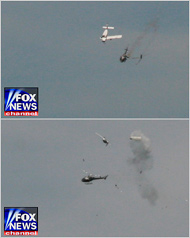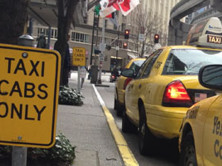
imediaethicsdiscovered it was FDNY Ladder Company 5 who, at 11:54 a.m., directly radioed-in the Aug.8 midair collision to FDNY Communications. The New York Times made errors in its Aug. 8 and 9 reports due to their failure to verify the FAA's "preliminary" time of 11:56 a.m. with the FDNY. The FDNY had the definitive, computer-documented time of 11:54 a.m. It was the first report made seconds after the crash by firefighters who watched it happen. The New York Times used the Fox News images above as part of their reportage. In addition to calling FDNY, the Times could have asked Fox News for the time stamp from the metatags of these impact photos to establish the correct crash time.
The New York Times muffed their reportage of the August 8 mid-air collision between a tourist helicopter and single-engine airplane by failing to call the FDNY and NYPD to quickly establish the most accurate information about the time. This failure to call local agencies resulted in the Times making significant errors—one particularly embarrassing—in two separate reports.
The report for the collision occurred at 11:54 a.m., August 8, 2009. The operations records of the FDNY indicate that Ladder Company 5 firefighters, not distressed citizens, were the first to call-in the collision of a tourist helicopter and a small plane traveling from New Jersey. Firefighters spotted the plummeting aircraft that quickly disappeared into the Hudson River depths while performing training exercises on Christopher Street in downtown Manhattan.
The above information gathered by imediaethics.org was unknown to the New York Times and therefore not mentioned in their August 8 and 9 reports. Why? I have been told by Times reporter, Serge F. Kovaleski via email (who asked me not to quote him) that the Times “authorities” consisted of asking the Federal Aviation Administration (FAA), multiple times, concerning what time the crash occurred—not New York City’s first responder agencies.
Here is the problem: The FAA, a federal agency, lost track of the plane and only heard from other agencies that the crash had occurred. They were unaware of these details—of what time reports of the crash first reached the FDNY Communications Office—in the first days following the crash. The same goes for the National Transportation Safety Board (NTSB), in charge of the accident. Note what Ted Lopatkiewicz, Director of Public Affairs for NTSB, said by email when I asked what time they first took charge of the August 8 aviation accident (emphasis mine), “We are officially in charge when we receive notification of an aviation accident.”
The NTSB takes care and time collecting information from other agencies, (the NTSB only released a final time on Aug 14, 11:53:14a.m. —a week after the crash ); however, a quick call by the Times to local agencies, FDNY and NYPD, who are also NTSB sources, would have revealed the accurate time of 11:54 a.m. as when Ladder 5 radioed-in report seconds after the collision
In other words, the NTSB’s first stated time of the crash “about noon” and the FAA’s time, “about” 11:56 a.m., are only “preliminary” statements. They must be checked against local agency reports of when the crash was first observed and by whom. For whatever reason, the New York Times failed to do this.
As it turns out, the first report to the FDNY Borough Communications Office was from its own first responders. The members of Ladder Company 5, who witnessed the crash, called the alarm into their Communications Office via their apparatus radio. Their communication with the borough dispatcher is recorded and this data is readily retrievable.
Here are the errors…
August 9th report
The New York Times report, “Deadly End for Groups on 2 Trips of Leisure,” written by Serge F. Kovaleski and Michael M. Grynbaum states (emphasis mine):
“At 11:50 a.m. Saturday, Steven M. Altman set off from Teterboro Airport in northern New Jersey at the controls of a single-engine Piper airplane for what should have been a routine, short flight to the Jersey Shore. Nearby sat Daniel Altman, his brother and partner in the family’s real estate business, and a teenage boy. The three had been in the air for only about six minutes when, according to the authorities….”
As I wrote in an August 11 imediaethics post, as well as above, first reports to FDNY were 11:54 a.m. Yet the the Times reports that “authorities,” who they do not name, say the crash occurred at “about” 11:56 a.m. If the Times would have fact checked with FDNY and/or NYPD they would have not made this error—namely citing a time of the crash that was well after reports that the aircraft were already in the Hudson River.
Kovaleski, the New York Times reporter, told me by email that they only asked the FAA multiple times over two days about the time of the crash, not local agencies. This was an error–especially given that the Aug. 9 story was one day after the crash and a rigorous time was readily available and verifiable.
As discussed above, the FDNY Communications Office, who receives calls directly from the general public (via 911) and units in the field—records and stores all their communications information utilizing computers. In this incident, they had the most accurate time available. NYPD concurred with FDNY, according to their press office, and they used the same 11:54 a.m. as the time of the first report of the crash that was first called in by Ladder 5.
The Times should have sourced the time they used as coming from FAA instead of saying unnamed “authorities.” Stating “authorities” implies multiple agencies were relied upon by the New York Times which unfairly gave weight to an erroneous approximation.
Indeed, the New York Times got it right–11:53 a.m.—in their interactive graphic—so someone over there must have called FDNY or NYPD.
August 8, 2009
The Times report, “A Flight Later, 2 Deaths Avoided, “ written by Serge F. Kovaleski and Michael M. Grynbaum states (emphasis mine):
“Paola Casali, 42, a tourist from Rome, was hoping to make a midday helicopter tour with her 13-year-old son, Lorenzo, from the West 30th Street heliport on Saturday, but she arrived shortly after the doomed helicopter had left. Two days earlier, she had called Liberty Helicopters to reserve seats on a tour for her and her son, and was told to be at the heliport on Saturday between noon and 1 p.m.”
As I previously reported, the error about the tourists is self-evident. Like a chair with the legs cut right from under it, the entire premise of the story collapses when the time of the crash (11:54)—or even the Times erroneous time (11:56) is known to the reader.
The truth is even if the tourists were on time— at 12:00 pm—they were still never at risk of death, as the doomed craft left earlier than when she was allegedly told to be there. Liberty Helicopter’s operations and reservations personnel both said the only instruction they provide with any reserved time, that they require, is for passengers to arrive one-half-hour before their flight. Given what the woman said, it is likely that the Italian tourists reserved flight would be 12:30 pm at the earliest, making her risk for having died on the doomed flight that left before noon at nil.
The point of the August 8 story was captured in the Times headline: “A Flight Later, 2 Deaths Avoided”.
That is to say, the tourists “avoided” their “deaths” by arriving “a flight later.” In other words–they were late or they would have been on the flight and dead– was the obvious meaning. This is wrong according to the facts the Times cites. In fact, according to their report, even if she were on time, she would have avoided death because she wasn’t told to arrive (after calling “to reserve seats”) until after the doomed tour took off, crashed and was reported in the water at 11:54 am.
Conclusion
Why is it so difficult to get these corrections at the Times? This is not an error made by FAA or NTSB per se, but born of not picking up the phone to call FDNY, NYPD or not understanding that NTSB was in charge, not FAA, and that they were still collecting information from other agencies, such as FDNY and NYPD, who were the first to receive reports of a crash. You would think the Times would be savvy enough to go to first responder sources– NTSB’s sources— to check the FAA crash time estimate via computer documented information.
No federal agency was wrong. It behooved the Times to find the most accurate available information and to seek out local agencies. One has to know that FAA and NTSB are still gathering facts Aug 8-9 and therefore only providing approximations during the early stages following the crash. It is the responsibility of news outlets to go to first responder agencies where NTSB will eventually collect its authoritative information –in this case the FDNY.
On Friday NTSB announced the exact time of the collision –11:53.14am.
However on Aug 8- 9, The NY Times should have easily known that FAA’s 11:56a.m. estimate was an inaccurate time in comparison to the FDNY Communications Office computer recorded data (11:54a.m.).
The temptation to report an eyewitness OMG “I was nearly on that flight” article is always there. Here is one from a recent crash titled: “I missed flight 3407”.
Embarrassing in this case of the Times’ August 8 report, is that they provide evidence internal to their own report that the claim of the near death of the tourists is untrue. I asked NTSB Terry Williams in their press office about the realities of chasing facts for their reports. “Is it not the case that you take the larger view of collecting information as lead agency from multiple agencies and since a complete report is a slow process, news outlets need mine their own information and do verification of your preliminary facts? “You are correct” Williams said by phone.
Feeling like master of the obvious, I also asked him about the tourists who the media reported cheated death by arriving late. I said, “Since the collision was reported by 11:54am, even if the tourists were to arrive on time (12-1pm) they would not have been on the fatal flight?”
Always consummate professionals, Williams spared me humiliation by not answering, “duh.”
Williams simply said, “That’s correct.”
Now where is the Times correction?
UPDATED: 09/17/09: 5:32p.m. Fixed typo.




